|
The Pharaoh's Journey to the Afterlife
The adventures of Alexander and his search for the Immortal
Ancestors clearly comprised elements which simulated their
experiences: caverns, angels, subterranean fires, fiery horses and
Chariots of Fire. But it is equally clear that, in the centuries
preceding the Christian era, it was believed (by Alexander or by his
historians or by both) that if one wished to attain Immortality, one
had to emulate the Egyptian Pharaohs.
Accordingly, Alexander's claim to semi-divine ancestry was evolved
from a complicated affair by an Egyptian deity, rather than by
simply claiming affinity to a local Greek God. It is an historical
fact, not mere legend, that Alexander found it necessary, as soon as
he broke through the Persian lines in Asia Minor, not to pursue the
Persian enemy, but to go to Egypt; there to seek the answer to his
purported divine "roots," and from there to begin the search for the
Waters of Life.
Whereas the Hebrews, the Greeks and other peoples in antiquity
recounted tales of a unique few who were able to escape a mortal's
fate by divine invitation, the ancient Egyptians developed the
privilege into a right. Not a universal right, nor a right reserved
to the singularly righteous; but a right attendant on the Egyptian
king, the Pharaoh, by sole virtue of having sat on the throne of
Egypt. The reason for this, according to the traditions of ancient
Egypt, was that the first rulers of Egypt were not men but Gods.
Egyptian traditions held that in times immemorial "Gods of Heaven"
came to Earth from the Celestial Disk (Fig. 7). When Egypt was
inundated by waters, "a very great God who came forth (to Earth) in
the earliest times" arrived in Egypt and literally raised it from
under the waters and mud, by damming the waters of the Nile and
undertaking extensive dyking and land reclamation works (it was
therefore that Egypt was nicknamed "The Raised Land").
This olden
God was named PTAH—'The Developer." He was considered to have been a
great scientist, a master engineer and architect, the Chief
Craftsman of the Gods, who even had a hand in creating and shaping
Man. His staff was frequently depicted as a graduated stick—very
much like the graduated rod which surveyors employ for field
measuring nowadays (Fig. 7).
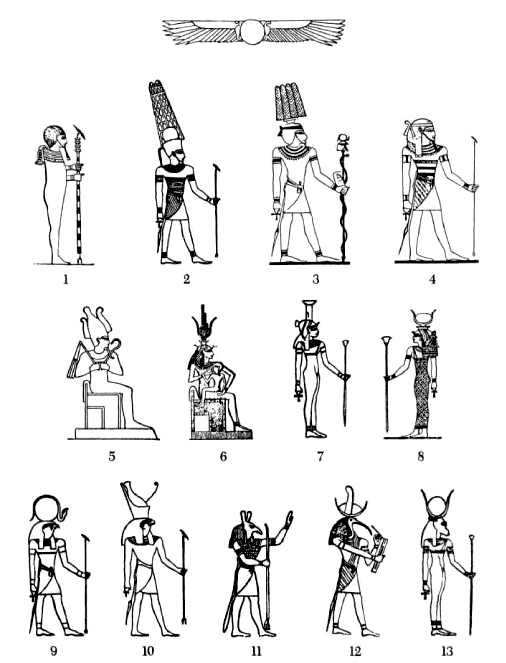
Fig. 7
THE CELESTIAL DISK AND THE Gods OF EGYPT
1. Ptah
2. Ra-Amen
3. Thoth
4. Seker
5. Osiris
6. Isis with Horus
7. Nephtys
8. Hathor
The Gods with their attributes;
9. Ra/Falcon
10. Horus/Falcon
11. Seth/Sinai Ass
12. Thoth/Ibis
13. Hathor/Cow
The Egyptians believed that Ptah eventually retired south, where he
could continue to control the waters of the Nile with sluices he had
installed in a secret cavern, located at the first cataract of the
Nile (the site of today's Aswan Dam). But before leaving Egypt, he
built its first hallowed city and named it AN, in honor of the God
of the Heavens (the biblical On, whom the Greeks called Heliopolis).
There, he installed as Egypt's first Divine Ruler his own son RA (so
named in honor of the Celestial Globe).
Ra, a great "God of Heaven and Earth," caused a special shrine to be
built at An; it housed the Ben-Ben—a "secret object" in which Ra had
purportedly come down to Earth from the heavens.
In time Ra divided the kingdom between the Gods OSIRIS and SETH. But
the sharing of the kingdom between the two divine brothers did not
work. Seth kept seeking the overthrow and death of his brother
Osiris. It took some doing, but finally Seth succeeded in tricking
Osiris into entering a coffin, which Seth promptly set to seal and
drown. ISIS, the sister and wife of Osiris, managed to find the
coffin, which had floated ashore in what is nowadays Lebanon.
She
hid Osiris as she went to summon the help of other Gods who could
bring Osiris back to life; but Seth discovered the body and cut it
to pieces, dispersing them all over the land. Helped by her sister
NEPHTYS, Isis managed to retrieve the pieces (all except for the
phallus) and to put together the mutilated body of Osiris, thereby
resurrecting him.
Thereafter, Osiris lived on, resurrected, in the Other World among
the other celestial Gods. Of him the sacred writings said:
He entered the Secret Gates,
The glory of the Lords of Eternity,
In
step with him who shines in the horizon,
On the path of Ra.
The place of Osiris on the throne of Egypt was taken over by his son
HORUS. When he was born, his mother Isis hid him in the reeds of the
river Nile (just as the mother of Moses did, according to the
Bible), to keep him out of the reach of Seth. But the boy was stung
by a scorpion and died. Quickly, the Goddess his mother appealed to
THOTH, a God of magical powers, for help. Thoth, who was in the
heavens, immediately came down to Earth in Ra's "Barge of
Astronomical Years" and helped restore Horus to life.
Growing up, Horus challenged Seth for the throne. The struggle
ranged far and wide, the Gods pursuing each other in the skies.
Horus attacked Seth from a Nar, a term which in the ancient Near
East meant "Fiery Pillar." Depictions from pre-dynastic times showed
this celestial chariot as a long, cylindrical object with a
funnel-like tail and a bulkhead from which rays are spewed out, a
kind of a celestial submarine (Fig. 8). In front the Nar had two
headlights or "eyes," which according to the Egyptian tales changed
color from blue to red.
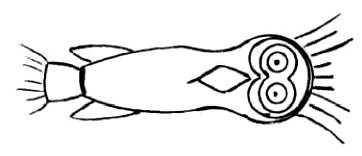
Fig. 8
There were ups and downs in the battles, which lasted several days.
Horns shot at Seth, from out of the Nar, a specially designed
"harpoon," and Seth was hurt, losing his testicles; this only made
him madder. In the final battle, over the Sinai peninsula, Seth shot
a beam of fire at Horus, and Horus lost an "eye." The great Gods
called a truce and met in council. After some wavering and
indecision, the Lord of Earth ruled in favor of giving Egypt to
Horus. declaring him the legitimate heir in the Ra-Osiris line of
succession.
(Thereafter, Horus was usually depicted with the
attributes of a falcon, while Seth was shown as an Asiatic deity,
symbolized by the ass, the burden animal of the nomads; Fig. 7).
The accession of Horus to the reunited throne of the Two Lands
(Upper Egypt and Lower Egypt) remained throughout Egyptian history
the point at which kingship was given its perpetual divine
connection; for every Pharaoh was deemed a successor of Horus and
the occupier of the throne of Osiris.
For unexplained reasons, the rule of Horus was followed by a period
of chaos and decline; how long this lasted, no one knows. Finally,
circa 3200 B.C., a "dynastic race" arrived in Egypt and a man named
Menes ascended the throne of a reunited Egypt. It was then that the
Gods granted Egypt civilization and what we now call Religion. The
kingship that was begun by Menes continued through twenty-six
dynasties of Pharaohs until the Persian domination in 525 B.C., and
then through Greek and Roman times (when the famed Cleopatra
reigned).
When Menes, the first Pharaoh, established the united kingdom, he
chose a midpoint in the Nile, just south of Heliopolis, as the place
for the capital of the two Egypts. Emulating the works of Ptah, he
built Memphis on an artificial mound raised above the Nile's waters,
and dedicated its temples to Ptah. Memphis remained the
political-religious center of Egypt for more than a thousand years.
Rut circa 2200 B.C. great upheavals befell Egypt, the nature of
which is not clear to scholars. Some think that Asiatic invaders
overran the country, enslaving the people and disrupting the worship
of their Gods. Whatever semblance of Egyptian independence remained,
it was retained in Upper Egypt—the less accessible regions farther
south. When order was restored
some 150 years later, political-religious power—the attributes of
kingship— flowed from Thebes, an old but until then unimposing city
in Upper Egypt, on the banks of the Nile.
Its God was called AMEN —"The Hidden One"—the very God Amnion whom
Alexander had searched out as his true divine father. As supreme
deity, he was worshipped as Amen-Ra, "The Hidden Ra"; and it is not
clear whether he was the very same Ra but now somehow unseen or
"hidden," or another deity.
The Greeks called Thebes Diospolis, "The City of Zeus," for they
equated Ammon with their supreme God Zeus. This fact made it easier
for Alexander to affiliate himself with Ammon; and it was to Thebes
that he rushed after he had received Amnion's favorable oracle at
the oasis of Siwa.
There, at Thebes and its precincts (now known as Karnak, Luxor,
Dier-el-Bahari), Alexander came upon the extensive shrines and
monuments to Ammon—impressive to this very day although they stand
empty and in ruins. They were built mostly by Twelfth Dynasty
Pharaohs, one of whom was probably the "Sesonchusis" who had
searched for the Waters of Life 1,500 years before Alexander. One of
the colossal temples was built by Queen Hatshepshut, who was also
said to have been a daughter of the God Ammon.
Such tales of divine parentage were not unusual. The Pharaoh's claim
to divine status, based on the mere fact of occupying the throne of
Osiris, was sometimes augmented by assertions that the ruler was the
son or the brother of this or that God or Goddess. Scholars consider
such statements to have only symbolic meaning; but some Egyptian
Pharaohs, such as three kings of the Fifth Dynasty, maintained that
they were actually, physically, the sons of the God Ra, begotten by
him when he impregnated the wife of the high priest in his own
temple.
Other kings attributed their descent from Ra to more sophisticated
means. It was claimed that Ra embodied himself in the reigning
Pharaoh, through which subterfuge he could then have intercourse
with the queen. Thereby, the heir to the throne could claim direct
descent of Ra. But apart from such specific claims to be of divine
seed, every Pharaoh was theologically deemed to be the incarnation
of Horus and thus by extension the son of the God Osiris.
Consequently, the Pharaoh was entitled to eternal life in the very
same manner experienced by Osiris: to resurrection after death, to
an Afterlife.
It was this circle, of Gods and God-like Pharaohs, that Alexander
longed to join.
The belief was that Ra and the other immortal Gods managed to live
forever because he kept rejuvenating himself. Accordingly, the
Pharaohs bore names meaning, for example, "He Who Repeats Births"
and "Repeater of Births." The Gods rejuvenated themselves by
partaking of divine food and
beverage at their abode. Therefore, the king's attainment of an
eternal Afterlife called for his joining the Gods in their abode, so
that he too could partake of their divine sustenances.
The ancient incantations appealed to the Gods to share with the
deceased king their divine food: "Take ye this king with you, that
he may eat of that which ye eat, that he may drink of which ye
drink, that he may live on that whereupon ye live." And more
specifically, as in a text from the pyramid of King Pepi:
Give thou sustenance to this King Pepi
From thy eternal sustenance;
Thy everlasting beverage.
The departed Pharaoh hoped to draw his everlasting sustenance in the
celestial realm of Ra, on the "Imperishable Star." There, in a
mystical "Field of Offerings" or "Field of Life," there grew the
"Plant of Life." A text in the pyramid of Pepi I describes him as
getting past guards with the appearance of "plumed birds," to be met
by the emissaries of Horus. With them,
He traveleth to the Great Lake,
by which the Great Gods alight.
These
Great Ones of the Imperishable Stargive unto Pepi the Plant of
Life
whereon they themselves do live,
so that he may also live
thereon.
Egyptian depictions showed the deceased (sometimes with his wife) at
this Celestial Paradise, sipping the Waters of Life out of which
there grows the Tree of Life with its life-giving fruit, the date
palm (Fig. 9).
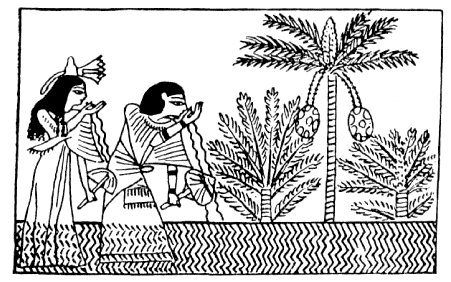
Fig. 9
The celestial destination was the birthplace of Ra, to which he had
returned from Earth. There, Ra himself was constantly rejuvenated or
"re-awakened" by having the Goddess of the Four Jars pour him a
certain elixir periodically. It was thus the king's hope to have the
same Goddess pour him too the elixir and "therewith refresh his
heart to life."
It was in these waters, named "Water of Youth," that
Osiris rejuvenated himself; and so it was promised to the departed
King Pepi that Horus shall "count for thee a second season of
youth"; that he shall "renew thy youth in the waters whose name is
'Water of Youth. "
Resurrected to Afterlife, even rejuvenated, the Pharaoh attained a
paradisiacal life:
"His provision is among the Gods; his water is
wine, like that of Ra. When Ra eats, he gives to him; when Ra
drinks, he gives to him."
And in a touch of twentieth century
psychotherapy, the text adds:
"He sleeps soundly every day ... he
fares better today than yesterday."
The Pharaoh seemed little bothered by the paradox that he had to die
Fig. 9
first in order to attain Immortality. As supreme ruler of the Two
Lands of Egypt, he enjoyed the best possible life on Earth; and the
resurrection among the Gods was an even more attractive prospect.
Besides, it was only his earthly body that was to be embalmed and
entombed; for the Egyptians believed that every person possessed a
Ba, akin to what we call "soul," which rose heavenward like a bird
after death; and a Ka—variably translated Double, Ancestral Spirit,
Essence, Personality—through which form the Pharaoh was translated
into his Afterlife.
Samuel Mercer, in his introduction to the
Pyramid Texts, concluded that the Ka stood for the mortal's
personification of a God. In other words, the concept implied the
existence in Man of a divine element, a celestial or Godly Double
who could resume life in the Afterlife.
But if Afterlife was possible, it was not easily attained. The
departed king had to traverse a long and challenging road, and had
to undergo elaborate ceremonial preparations before he could embark
on his journey.
The deification of the Pharaoh began with his purification and
included embalmment (mummification), so that the dead king would
resemble Osiris with all his members tied together. The embalmed
Pharaoh was then carried in a funerary procession to a structure
topped by a pyramid, in front of which there stood an oval-shaped
pillar (Fig. 10).
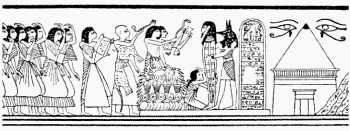
Fig.10
Within this funerary temple, priestly rites were conducted with a
view to achieving for the Pharaoh acceptance at journey's end. The
ceremonies, called in the Egyptian funerary texts the "Opening of
the Mouth," were supervised by a Shem priest—always depicted wearing
a leopard skin (Fig. 11).
Scholars believe that the ritual was
literally what its name implies: the priest, using a bent copper or
iron tool, opened the mouth of the mummy or of a statue representing
the departed king. But it is clear that the
ceremony was primarily symbolic, intended to open for the deceased
the "mouth" or Entranceway to the Heavens.
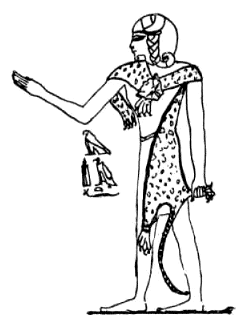
Fig.11
The mummy, by then, was tied up tight in many layers of material and
was surmounted by the king's golden death mask. Thus, the touching
of its mouth (or that of the king's statue) could have been only
symbolical. Indeed, the priest intoned not the deceased, but the
Gods to "open the mouth" so that the Pharaoh could ascend toward
eternal life. Special appeals were made to the "Eye" of Horus, lost
by him in the battle with Seth, to cause the "opening of the mouth"
so that "a path shall be opened for the king among the Shiny Ones,
that he may be established among them."
The earthly (and thus by conjecture only temporary) tomb of the
Pharaoh—according to the texts and actual archaeological
discoveries—had a false door on its eastern side, i.e. the masonry
was built there to look like a doorway, but it was actually a solid
wall. Purified, with all limbs tied together, "opened of mouth," the
Pharaoh was then envisioned as raising himself, shaking off Earth's
dust, and exiting by the false door.
According to a Pyramid Text
which dealt with the resurrection process step by step, the Pharaoh
could not pass through the stone wall by himself.
"Thou standest at
the doors which hold people back," the text said, until "he who is
chief of the department"—a divine messenger in charge of this
task—"comes out to thee. He lays hold on thy arm, and takes thee to
heaven, to thy father."
Aided thus by a divine messenger, the Pharaoh was out of his sealed
tomb, through the false door. And the priests broke out in a chant:
"The king is on his way to Heaven! The king is on his way to
Heaven!"
The king is on his way to Heaven
The king is on his way to Heaven
On
the wind, on the wind.
He is not hindered;
There is no one by whom he
is hindered.
The king is on his own, son of the Gods.
His bread will
come on high, with Ra;
His offering will come out of the Heavens.
The
king is he "Who Comes Again."
But before the departed king could ascend to Heaven to eat and drink
with the Gods, he had to undertake an arduous and hazardous Journey.
His goal was a land called Neter-Khert, "The Land of the Mountain
Gods." It was sometimes written pictorially in hieroglyphic by
surmounting the
symbol for God (Neter)
upon a ferry boat
; and indeed, to reach
that land, the Pharaoh had to cross a long and winding Lake of
Reeds. The marshy waters could be crossed with the aid of a Divine
Ferryman, but before he would ferry the Pharaoh over he questioned
the king about his origins: What made him think he had the right to
cross over? Was he a son of a God or a Goddess?
Beyond the lake, past a desert and a chain of mountains, past
various guardian Gods, lay the Duat, a magical "Abode for rising to
the Stars," whose location and name have baffled the scholars. Some
view it as the Netherworld, the abode of the spirits, where the king
must go as Osiris did. Others believe it was an Underworld, and
indeed much of its scenes were of a subterranean world of tunnels
and caverns with unseen Gods, pools of boiling waters, eerie lights,
chambers guarded by birds, doors that open by themselves. This
magical land was divided into twelve divisions, and was traversed in
twelve hours.
The Duat was further perplexing, because in spite of its terrestrial
nature (it was reached after crossing through a mountain pass) or
subterranean aspects, its name was written hieroglyphically with a
star and a soaring
falcon as its determinatives
or simply with a star within a
circle , denoting a celestial or heavenly association.
Baffling as it
has been, the fact is that the Pyramid Texts, as they followed
the Pharaoh's progress through his life, death, resurrection and
translation to an Afterlife, considered the human problem to be the
inability to fly as the Gods do. One text summed up this problem and
its solution in two sentences: "Men are buried, the Gods fly up.
Cause this king to fly to Heaven, (to be) among his brothers the
Gods." A text inscribed in the pyramid of King Teti expressed the
Pharaoh's hope and appeal to the Gods in these words:
Men fall,
They have no Name.
Seize thou king Teti by his arms,
Take thou king Teti to the sky,
That he die not on Earth among men.
And so it was incumbent upon the king to reach the "Hidden Place,"
and go through its subterranean labyrinths until he could find there
a God who carries the emblem of the Tree of Life, and a God who is
the "Herald of Heaven." They will open for him secret gates, and
lead him to the Eye of Horus, a Celestial Ladder into which he would
step—an object which can change hues to blue and red as it is
"powered."
And then, himself turned into the Falcon-God, he would
soar skyward to the eternal Afterlife on the Imperishable Star.
There, Ra himself would welcome him:
The Gates of Heaven are opened for thee;
The doors of the Cool Place are opened for thee.
Thou shalt find Ra standing, waiting for thee.
He will take your hand,
He will take thee to the Dual Shrine of Heaven;
He will place thee on the throne of Osiris ...
Thou shalt stand supported, equipped as a God ...
Among the Eternals, on the Imperishable Star.
Much of what is known today on the subject comes from the Pyramid
Texts—thousands of verses combined into hundreds of Utterances, that
were discovered embossed or painted (in the hieroglyphic writing of
ancient Egypt) on the walls, passages and galleries of the pyramids
of five Pharaohs (Unas, Teti, Pepi I, Merenra and Pepi II) who ruled
Egypt from circa 2350 B.C. to 2180 B.C. These texts were sorted out
and numbered by Kurt Sethe in his masterful Die altaegyptischen
Pyramidentexte, which has remained the major reference source
together with the English counter-part, The Pyramid Texts by Samuel
A. B. Mercer.
The thousands of verses that make up
the Pyramid Texts seem to be
just a collection of repetitious, unconnected incantations, appeals
to the Gods or exaltations of the king. To make some sense of the
material, scholars have developed theories about shifting theologies
in ancient Egypt, a conflict and then a merger between a "Solar
Religion" and a "Sky Religion," a
priesthood of Ra and one of Osiris, and so on, pointing out that we
deal with material that has been accumulated over millennia.
To scholars who view the mass of verses as expressions of primitive
mythologies, figments of the imagination of people who cowered in
fear as the wind howled and the thunder roared and called these
phenomena "Gods"—the verses remain as puzzling and confusing as
ever. But these verses, all scholars agree, were extracted by the
ancient scribes from older and apparently well-organized, cohesive
and comprehensible scriptures.
Later inscriptions on sarcophagi and coffins, as well as on papyrus
(the latter usually accompanied by illustrations) indeed show that
the verses, Utterances and Chapters (bearing such names as "Chapter
of those who ascend") were copied from "Books of the Dead," which
bore such titles as "That Which Is in the Duat," "The Book of the
Gates," "The Book of the Two Ways." Scholars believe that these
"books" in turn were versions of two earlier basic works: olden
writings that dealt with the celestial journey of Ra, and a later
source which stressed the blissful Afterlife of those who join
Osiris resurrected: the food, the beverage, the conjugal joys in a
heavenly abode. (Verses of this version were even inscribed on
talismans, to achieve for their wearer "union with women by day or
night" and the "desire of women" at all times.)
The scholarly theories, however, leave unexplained the magical
aspects of the information offered by these texts. Bafflingly, an
Eye of Horus is an object existing independently of him—an object
into whose insides the king can enter, and which can change hues to
blue and red as it is "powered." There exist self-propelled ferries,
doors that open by themselves, unseen Gods whose faces radiate a
glow. In the Underworld, supposedly inhabited by spirits only,
"bridge girders" and "copper cables" are featured. And the most
baffling aspect of all: Why, if the Pharaoh's transfiguration takes
him to the Underworld, do the texts claim that "the king is on his
way to Heaven"?
Throughout, the verses indicate that the king is following the route
of the Gods, that he is crossing a lake the way a God had crossed it
before, that he uses a barque as the God Ra had done, that he
ascends "equipped as a God" as Osiris was, and so on and on. And the
question arises: What if these texts were not primitive
fantasies—mythology—but accounts of a simulated journey, wherein the
deceased Pharaoh emulated what the Gods had actually done? What if
the texts, substituting the name of the king for that of a God, were
copies of some much earlier scriptures that dealt not with the
journeys of the Pharaohs, but with the journeys of the Gods?
One of the early leading Egyptologists, Gaston Maspero
(L'Archeologie egyptienne and other works), judging by grammatical
form and other evidence, suggested that the Pyramid Texts originated
at the very beginning of Egyptian civilization, perhaps even before
they were written down hieroglyphic-ally. J. H. Breasted has more
recently concluded (Development of Religion and Thought in Ancient
Egypt) that "such older material existed, whether we possess it or
not."
He found in the texts
information on the conditions of civilization and events which
enhances the veracity of the texts as conveyors of factual
information and not of fantasy.
"To one of quick imagination," he
says, "they abound in pictures from the long-vanished world of which
they are a reflection."
Taken together, the texts and later illustrations describe a journey
to a realm that begins above ground, that leads underground, and
that ends with an opening to the skies through which the Gods—and
the kings emulating them—were launched heavenward (Fig. 12). Thus
the hieroglyphic connotation combining a subterranean place with a
celestial function.
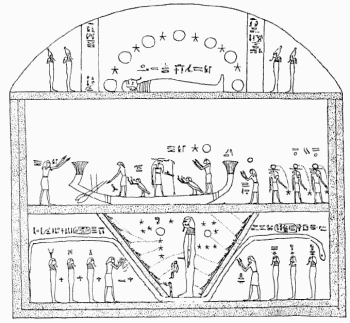
Fig. 12
Have the Pharaohs, journeying from their tombs to the Afterlife,
actually taken this Route to Heaven? Even the ancient Egyptians
claimed the journey not for the mummified corpse, but for the Ka
(Double) of the departed king. But they have envisioned this Double
as re-enacting actual progress through actual places.
What, then, if the texts reflect a world which had indeed
existed—what if the Pharaoh's Journey to Immortality, even if only
by emulation, indeed followed step by step actual journeys
undertaken in prehistoric times?
Let us follow in these footsteps; let us take the Route of the Gods.
Back to Contents
|





